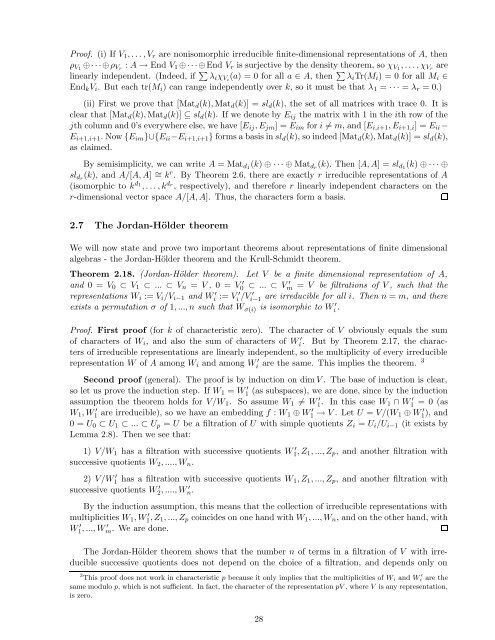Lecture notes for Introduction to Representation Theory
Lecture notes for Introduction to Representation Theory
Lecture notes for Introduction to Representation Theory
You also want an ePaper? Increase the reach of your titles
YUMPU automatically turns print PDFs into web optimized ePapers that Google loves.
⇒<br />
⇒<br />
Proof. (i) If V 1 , . . . , V r are nonisomorphic irreducible finite-dimensional representations of A, then<br />
δ V1 · · · δ Vr : A ⊃ End V 1 · · · End V r is surjective by the density theorem, so ν V1 , . . . , ν Vr are<br />
linearly independent. (Indeed, if ⎨ ∂ i ν Vi (a) = 0 <strong>for</strong> all a A, then ⎨ ∂ i Tr(M i ) = 0 <strong>for</strong> all M i <br />
End k V i . But each tr(M i ) can range independently over k, so it must be that ∂ 1 = · · · = ∂ r = 0.)<br />
(ii) First we prove that [Mat d (k), Mat d (k)] = sl d (k), the set of all matrices with trace 0. It is<br />
clear that [Mat d (k), Mat d (k)] ∧ sl d (k). If we denote by E ij the matrix with 1 in the ith row of the<br />
jth column and 0’s everywhere else, we have [E ij , E jm ] = E im <strong>for</strong> i = m, and [E i,i+1 , E i+1,i ] = E ii −<br />
E i+1,i+1 . Now {E im }⊗{E ii −E i+1,i+1 } <strong>for</strong>ms a basis in sl d (k), so indeed [Mat d (k), Mat d (k)] = sl d (k),<br />
as claimed.<br />
By semisimplicity, we can write A = Mat d1 (k) · · · Mat dr (k). Then [A, A] = sl d1 (k) · · · <br />
sl dr (k), and A/[A, A] ∪ = k r . By Theorem 2.6, there are exactly r irreducible representations of A<br />
(isomorphic <strong>to</strong> k d 1<br />
, . . . , k dr , respectively), and there<strong>for</strong>e r linearly independent characters on the<br />
r-dimensional vec<strong>to</strong>r space A/[A, A]. Thus, the characters <strong>for</strong>m a basis.<br />
2.7 The Jordan-Hölder theorem<br />
We will now state and prove two important theorems about representations of finite dimensional<br />
algebras - the Jordan-Hölder theorem and the Krull-Schmidt theorem.<br />
Theorem 2.18. (Jordan-Hölder theorem). Let V be a finite dimensional representation of A,<br />
and 0 = V 0 → V 1 → ... → V n = V , 0 = V<br />
<br />
0 → ... → V<br />
<br />
m = V be filtrations of V , such that the<br />
representations W i := V i /V i−1 and W := V i /V<br />
<br />
i<br />
i−1 are irreducible <strong>for</strong> all i. Then n = m, and there<br />
exists a permutation ε of 1, ..., n such that W ε(i) is isomorphic <strong>to</strong> W i .<br />
Proof. First proof (<strong>for</strong> k of characteristic zero). The character of V obviously equals the sum<br />
of characters of W i , and also the sum of characters of W i . But by Theorem 2.17, the characters<br />
of irreducible representations are linearly independent, so the multiplicity of every irreducible<br />
representation W of A among W i and among W i are the same. This implies the theorem. 3<br />
Second proof (general). The proof is by induction on dim V . The base of induction is clear,<br />
so let us prove the induction step. If W 1 = W 1 (as subspaces), we are done, since by the induction<br />
assumption the theorem holds <strong>for</strong> V/W 1 . So assume W 1 = W 1 . In this case W 1 ∈ W<br />
<br />
1 = 0 (as<br />
W 1 , W<br />
<br />
1 are irreducible), so we have an embedding f : W 1 W 1 ⊃ V . Let U = V/(W 1 W 1 ), and<br />
0 = U 0 → U 1 → ... → U p = U be a filtration of U with simple quotients Z i = U i /U i−1 (it exists by<br />
Lemma 2.8). Then we see that:<br />
1) V/W 1 has a filtration with successive quotients W 1 , Z 1 , ..., Z p , and another filtration with<br />
successive quotients W 2 , ...., W n .<br />
2) V/W 1<br />
<br />
has a filtration with successive quotients W 1 , Z 1 , ..., Z p , and another filtration with<br />
successive quotients W 2 , ...., W n .<br />
By the induction assumption, this means that the collection of irreducible representations with<br />
multiplicities W 1 , W 1 , Z 1 , ..., Z p coincides on one hand with W 1 , ..., W n , and on the other hand, with<br />
W 1 , ..., W . We are done.<br />
m<br />
The Jordan-Hölder theorem shows that the number n of terms in a filtration of V with irreducible<br />
successive quotients does not depend on the choice of a filtration, and depends only on<br />
3 ⊗<br />
This proof does not work in characteristic p because it only implies that the multiplicities of W i and W i are the<br />
same modulo p, which is not sufficient. In fact, the character of the representation pV , where V is any representation,<br />
is zero.<br />
28

















